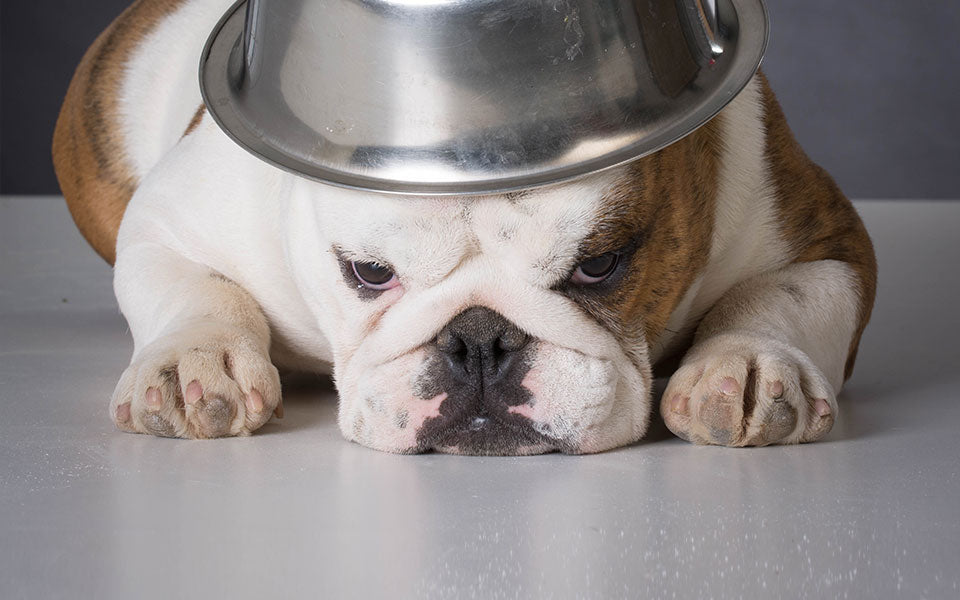
6 Foods That Are Bad For Dogs (and 4 to Feed Carefully)
Look up an article on healthy foods for people and you’ll find some familiar and popular items.
Garlic can help boost your immune system, lower your cholesterol and contains antioxidants to rid your body of free radicals. Dark chocolate lowers blood pressure, reduces risk of heart disease, and has antioxidant power. Kale is rich in protein, vitamins, fiber, and omega-3 fatty acids...
But taking a list like this and using it as a guideline for your pup is a problem. Why? Because as much as your pooch is a family member and your four-legged fur baby, a dog is simply not a small human.
Dogs digest and process many things differently than we do and as such, several items that are very healthy for pet parents, are not good to feed to their pups.
Following are 10 foods that should either be completely avoided in dogs, or for several of them, fed with caution and moderation (not to worry, it’ll be clear which is which).
Toxic Foods to Completely Avoid
1. Decadent but Disastrous: Chocolate
Chocolate contains methylzanthines, the same as coffee. Methylzanthines elevate heart rate and intestinal movement. In people, these signs can be mild, depending on sensitivity. But in dogs, small amounts of chocolate, coffee beans, or espresso beans (and especially chocolate-covered espresso beans!) can cause severe illness.
Not all dogs are created equal and not all chocolate is created equal. To illustrate, we’ll use the Veterinary Information Network’s chocolate toxicity calculator. Take a 5lb Chihuahua and a 65lb Labrador, both eating a 1.5 ounce chocolate bar (about the size of an average Hershey bar). If the Chihuahua eats a 1.5 ounce milk chocolate bar, she’ll have vomiting, diarrhea, heart arrhythmias, and be very close to seizing. The Labrador will be completely fine. Now change the chocolate from milk chocolate to 86% cocoa. The Chihuahua will unfortunately be at high risk for seizures and death. The Labrador will only start having signs of vomiting and diarrhea. Double the amount to two bars and our Labrador will be in bad shape too.
This is why it’s extremely important to give your vet clinic a call, as it may be important for your pup to be treated, depending on how big she is, what kind of chocolate she ate, and how much.

2. Hold Your Breath: Garlic
Along with onions and chives, garlic is very dangerous to feed to our pups. While a couple chopped pieces for a large dog may be harmless, a full clove of garlic for a small dog can be deadly. Garlic and onions possess a variety of sulfur-containing oxidants, causing oxidative damage to red blood cells and leading to a condition called Heinz body anemia where the red blood cells become deformed and are selectively destroyed by the body’s filtering system in the spleen.
The odiferous nature of garlic is caused by these sulfur compounds and as a general rule, the more odiferous the garlic product, the more toxic potential it has. Both raw garlic and cooked garlic can be toxic, as cooking releases additional sulfur compounds.
Let’s generate an example and take our Chihuahua and Labrador from before. It only takes about 5 grams of garlic per 2 pounds of body weight to cause a clinical Heinz body anemia. For the Chihuahua, this may only be 1-2 cloves of garlic. The average clove ranges from 4 to 10 grams. For the 65lb Labrador though, he would need to eat at least 2 full bulbs of garlic (containing several cloves each) for the same effect. Onions are about 3 times less toxic than garlic, but the same principle applies.
Similar caution goes for garlic and onion powders. These products may actually be worse, due to their dehydrated, concentrated nature. There are some products out there described as “deodorized” or “odor free”. These products may be less toxic as most of the sulfur-containing compounds have been removed.
3. The Mystery of Grapes and Raisins
Sometime around the turn of the century, data collected by the Animal Poison Control Center, a division of the ASPCA, showed an alarming trend. A surprisingly high number of dogs exhibiting signs of kidney failure had a history of ingesting grapes or raisins.
Unfortunately, the toxic principle behind grape and raisin toxicity is still a mystery. No one knows why it happens, or why it only happens to some dogs but not to others. I have heard anecdotal stories of a dog’s owner feeding his pup grapes as treats for his friend’s whole life with not a care in the world. But I can tell you from personal experience that just two or three grapes can send some dogs into acute kidney failure.
Because no one knows which dogs are safe, which ones are not, and no toxic dose has even been established (we assume a single grape can do it) grapes and raisins should be avoided altogether.
4. The Equally Mysterious Macadamia Nut
Macadamia nuts are a popular tree nut to include in cookies and other baked goods and snacks. But if a dog eats just 1 nut per 2 pounds of body weight, some very weird things can happen. The phenomenon is only known to occur in dogs, and can include include extremely elevated temperature, muscle tremors, weakness, diarrhea, and vomiting.
Fortunately, with supportive care at a vet clinic, affected dogs can make a full recovery.
Unfortunately, no one yet knows the toxic principle behind macadamia nut toxicity, kind of like with grapes and raisins. So if you happen to cook with them, keep them far out of reach. More importantly, check the ingredients for any baked goods you purchase.
5. Deep Trouble with the Deep Fryer: High Fat and Fried Foods
It’s true, this category contains a limitless possibility of foods, but I consider anything fried with lots of fat and grease to be toxic for pups. High fat and fried foods are very difficult for dogs to digest and can lead to severe gastrointestinal illness, especially pancreatitis.
Now, many folks know that they shouldn’t feed a deep-fried oreo to their dog. But what worries me as a vet more, are the accidental ingestions. Leaving cans of drained grease on the stove, or even leaving a paper towel at the top of the trash can, that was used to wipe a pan can be everyday actions we forget can put our furry friends at risk.
Make sure to keep grease in a place inaccessible to dogs, like the freezer. When throwing away the KFC and other table scraps, use a trash can with a lid that can lock. This way, even if your pup knocks the can over, it’ll still stay closed.
6. Give a Dog a Bone (Actually, Please Don’t)
Dogs stereotypically go with bones just as often as cats go with fish. But ironically, neither is a good food choice for either pet. Cats need the amino acid taurine, found only in red meat, which fish doesn’t have, but that’s another story.
Bones are not all created equal, but most of them cause more harm than good. The marrow on the end of bones can be very nutritious, this is true. But pork and beef bones, if fully ingested, cannot be digested. They generally pass through the digestive tract unchanged but more often, they get stuck...and require surgery to get out.
I have found that if a dog ingests chicken bones, say the leftovers from the buffalo wing party, that the wing sauce residue may cause more issues than the bones do. But it all depends on how they’re prepared. Because avian bones are hollow, an inherited feature that allows birds flight, they’re less dense and far more susceptible to enzymatic digestion. But if the bones are boiled, they cannot be broken down as easily and can be more dangerous.
Many a young dog has needed a premature dental cleaning and tooth removal because he broke a premolar chewing on a bone. This is the other reason I don’t recommend bones at home. The donut-shaped marrow bones are also a high risk for getting entrapped around your pup’s lower jaw. If this happens, the only way to get it off is to use a saw or dremel tool to remove it under heavy sedation or anesthesia. Enough reason to avoid these bones as treats.

When in doubt, just call!
If you think your pet may have ingested any of these toxic food items, it’s very important to give your vet clinic a call. With the exception of bones and a couple other things, inducing vomiting to remove an offending agent before the body can digest it, is common practice. It is also common to administer activated charcoal, which can help bind toxins that have already passed to the intestines, where nutrient absorption happens.
Our next section focuses on foods that aren’t necessarily bad for dogs, but should be fed selectively and cautiously depending on either where the foods are sourced from, what forms are available, or because too much of a good thing is still too much.
Foods to Feed with Caution
1. Fish
Fish is a great protein source. Rich in Omega fatty acids and Vitamin D, fish in general is great for dogs too. But there are two precautions to be aware of. Tuna should generally be avoided on a regular basis due to higher mercury levels. As detailed by the FDA here, several forms of Tuna are at the high end of the parts per million (PPM) mercury list. Fortunately, commercial fish diets typically contain whitefish, salmon, or other less long-lived fish with negligible mercury levels.
The other caution about fish is feeding raw fish. Raw diets have increased in popularity, but extreme caution needs to be taken with any raw food. Raw fish contains thiaminase, which breaks down thiamin, an important B Vitamin. Fish also carry parasites, like any wild animal can, and not cooking fish can expose your pet (and you) to these same parasites.
Is feeding tuna from a can occasionally as a treat a problem? Not at all and in fact, your pooch may love a spoonful once or twice a week as a treat. But make sure the can contains only tuna and some water with no additional salt added.
2. Seaweed
In the same category as kelp and nori, seaweed has become a popular health food, supporting thyroid function, boasting vitamins and minerals, antioxidants, and a great source of fiber. The same health benefits can transfer to your pup.
However, you have to be careful feeding these oceanic greens. Eating dried seaweed right off the beach is extremely dangerous. Seaweed shrinks and dehydrates in the sun. If a dog eats it, the seaweed can expand in the gastrointestinal tract, leading to a potential bowel obstruction.
Commercially prepared seaweed is far safer, but you still need to be careful. Because seaweed spends much of its life in the ocean, it can accumulate heavy metals, like arsenic and mercury. Knowing where your seaweed is farmed from makes a big difference. Avoid seaweed sourced from regions like Southeast Asia and Russia.
So in general, stick with commercially prepared items sourced from safe, non-polluted waters, and like canned tuna, feed at most as a treat once or twice a week.
3. Kale
This one may surprise many people because Kale is so popular and so healthy for humans. However, for some dogs, there is a risk eating kale. Kale contains high levels of calcium oxalate, which in dogs can lead to development of bladder or kidney stones.
Calcium oxalate stones cannot be dissolved by prescription diets and require surgery to remove from the bladder and urinary tract.
So while giving a small piece to your dog once in a while will probably cause no harm, feeding a lot on a regular basis should be avoided.
4. Liver
Liver is touted as a superfood powerhouse. It’s low in calories and as such, is one of the most nutritionally dense foods out there. It’s an excellent source of several vitamins and minerals. Liver is a great treat for dogs if fed only once or twice a week, about a tablespoon amount at a time.
However, too much of a good thing can be a bad thing. Liver has high levels of Vitamin A, a fat soluble vitamin. This means, that unlike B and C vitamins, which are water soluble, the body has a harder time eliminating Vitamin A. Over time, Vitamin A excesses accumulate in fat stores in the body. These excesses can lead to new bone formation around the joints, causing pain and poor mobility.
Again, when in doubt, just call!
Fortunately, the list of foods that are bad for dogs is not very long and there are many healthy human food items that are perfectly healthy for pups too. If you ever have doubts about whether something in your home could present a toxicity concern for your pooch, call your vet clinic or check out the ASPCA Poison Control Center website. They have full lists for not only human foods to avoid, but household products and plants as well.
Stay tuned for our fourth, and sadly, final email in our Dog Health Series. But not to worry! You’ll continue to receive articles aimed at benefiting you and your special pup, every month in our newsletter.
Next week, we’ll be discussing vitamins and supplements that can give your pup an extra pep in her step, and when to consider them.







